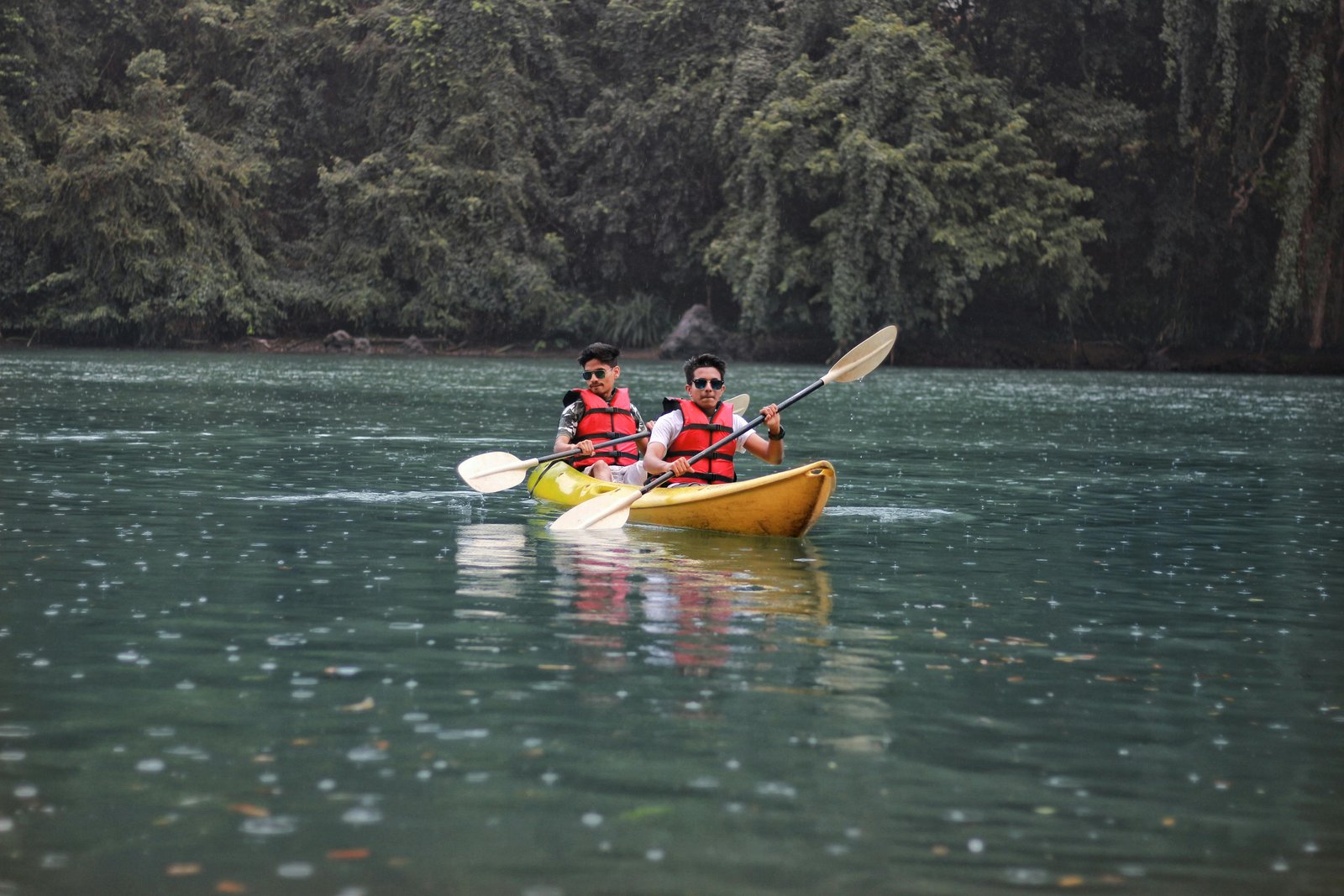Adventure therapy is an innovative therapeutic approach that blends traditional counseling techniques with engaging outdoor activities. You can address various emotional, psychological, and behavioural challenges by treating people with adventure therapy. It is done by leveraging the healing power of nature and physical activity to help individuals develop resilience, improve self-esteem, and enhance social skills. If you are considering a second career or looking for an opportunity to work abroad, you can definitely consider becoming an adventure therapist.
Being an adventure therapist allows you to combine a passion for the outdoors with a commitment to helping others, making it a rewarding choice for those seeking both personal and professional growth. Moreover, adventure therapy's global appeal and versatile applications offer numerous opportunities for practitioners to work in several environmental settings, from mountainous regions to coastal areas, providing a broad spectrum of experiences and cultural interactions.
Continue reading this if you want to know about adventure therapists, details about their role, core principles of adventure therapy, necessary qualifications, and the process. By the end of this piece, you will have a comprehensive understanding of what it takes to become an adventure therapist and how to embark on this career, either as a new career option or if you are planning to work abroad.

Who is an Adventure Therapist?
An adventure therapist is a licensed mental health professional who incorporates outdoor and experiential activities into therapy sessions to help clients address a wide array of psychological and emotional issues. They use nature and physical challenges to promote emotional healing and personal development.
Unlike traditional therapists who rely on verbal communication in an office setting, adventure therapists facilitate therapy in outdoor environments, engaging clients in hiking, rock climbing, canoeing, or wilderness exploration. These activities are not random but are carefully chosen to align with the therapeutic requirements of the client.
Their Role and Responsibilities
The primary role of an adventure therapist is to integrate nature and outdoor activities into structured therapeutic interventions. Their daily responsibilities include:
- Conducting initial assessments of the client’s mental health and physical fitness.
- Designing personalized adventure-based interventions that align with therapeutic goals.
- Leading clients through activities like hiking, kayaking, or climbing while maintaining a therapeutic focus.
- Managing safety protocols, and ensuring physical and emotional risks are minimized during outdoor sessions.
- Providing emotional support, helping clients process their experiences, and drawing connections between physical challenges and personal growth.
Adventure therapists often work with individuals struggling with issues like anxiety, depression, trauma, and behavioural disorders. They may also facilitate team-building sessions for corporate groups, lead therapy for teens, or work with veterans experiencing PTSD.

The Concept of Adventure Therapy
For a proper understanding of adventure therapy, and the functions and importance of an adventure therapist, it is important to understand the concept. Let’s understand its core principles.
Adventure therapy is grounded in several key principles:
- Experiential Learning: Clients learn through experience; by directly engaging with activities that mirror the challenges they face in life.
- Nature’s Healing Power: The natural environment provides a calming, rejuvenating setting that can reduce stress and anxiety, promoting mental clarity.
- Challenge by Choice: Clients are empowered to participate in activities at their comfort level, which fosters autonomy and self-confidence.
- Holistic Development: Adventure therapy seeks to nurture mental, physical, social, and emotional growth, promoting overall well-being.
- Respect and Responsibility: By engaging with nature and peers, participants learn to respect themselves, others, and the environment, fostering a sense of responsibility.
- Therapeutic Metaphors: Physical activities serve as metaphors for emotional and psychological struggles, helping clients gain new perspectives on their issues.
Therapeutic Techniques
Adventure therapists use a range of activities to promote healing and personal growth. Some adventure-based common techniques include:
- Group Dynamics and Team Building: Activities often involve groups, which help clients develop communication and social skills, build trust, and learn to work collaboratively towards common goals.
- Narrative Exploration: Through storytelling and reflection, individuals can re-frame their experiences, gaining perspective and understanding of their personal journeys.
- Problem-Solving Tasks: These tasks are designed to challenge clients' mental and emotional faculties, encouraging creative thinking and resilience.
- Hiking: Used to reduce stress, build endurance, and encourage mindfulness.
- Rock Climbing: Helps clients confront fear, develop problem-solving skills, and build trust in themselves and others.
- Canoeing/Kayaking: Teaches teamwork and requires participants to navigate challenges together, improving communication and collaboration.
- Wilderness Expeditions: Extended trips in nature, allowing clients to disconnect from daily stressors and focus on self-reflection and personal development.
These activities are designed to challenge the body and stimulate the mind, encouraging clients to confront their fears, set goals, and work through emotional blocks.
Who Needs it the Most?
Adventure therapy can benefit a wide range of individuals, but some specific groups that frequently benefit from this therapeutic approach include:
- Teens with Behavioural Issues: Adventure therapy is particularly effective for adolescents dealing with defiance, aggression, or substance abuse. The physical challenges help them build trust, responsibility, and self-esteem.
- Individuals with Anxiety or Depression: The calming effects of nature combined with the physical release of endorphins through exercise can help alleviate symptoms of anxiety and depression.
- Corporate Teams: Adventure therapy is often used in team-building exercises to improve communication, leadership skills, and group cohesion.
- Veterans and Trauma Survivors: Physical activities help veterans or trauma survivors rebuild confidence and cope with emotional scars. The structured environment of adventure therapy provides a safe space to process difficult emotions.
Embarking on a career as an adventure therapist requires a deep understanding of these principles, techniques, and the diverse populations that benefit from this innovative approach to therapy. By embracing both the challenges and rewards of this profession, aspiring therapists can make a meaningful impact, helping individuals and communities grow and heal through the power of adventure.
Qualifications and Training Required to Become an Adventure Therapist
A specifically designed curriculum empowers an aspirant with the required knowledge and suitable training
Educational Background
To become an adventure therapist, one generally starts with a solid educational foundation in fields related to psychology, counseling, social work, or mental health. A bachelor's degree in these areas provides a comprehensive understanding of human behaviour and mental health issues, which is essential for effective therapy.
- Bachelor’s Degree: Majoring in psychology, social work, or related fields lays the groundwork for understanding psychological principles and therapeutic relationships.
- Master’s Degree: Although not always mandatory, many employers prefer candidates with a master's degree in counseling, clinical psychology, or social work. Graduate programs often offer specialized courses in adventure therapy or experiential learning, equipping you with advanced theoretical and practical skills.
Professional Certifications
While a degree provides the theoretical knowledge needed for the job, professional certifications further equip adventure therapists with the necessary skills to safely manage outdoor activities. Some common certifications include:
- Certified Adventure Therapist (CAT): This certification is specifically designed for professionals who want to integrate adventure therapy into their practice.
- Wilderness First Responder (WFR): This certification ensures that therapists are prepared to handle medical emergencies that may arise during outdoor sessions.
- Outdoor Leadership Certifications: Different certifications in outdoor leadership or wilderness guiding may be required, depending on the activities that the therapist will engage in with clients.
- Adventure Therapy Certification: While not always mandatory, organizations such as the Association for Experiential Education offer specific certifications in adventure therapy, highlighting proficiency in utilizing adventure-based techniques for therapeutic purposes.
Specialized Training
Beyond formal education, adventure therapists often seek specialized training in areas such as mentioned below:
- Risk management: Knowing how to assess and mitigate potential hazards during outdoor activities.
- Therapeutic techniques: Advanced training in psychological theories and intervention strategies, ensuring that the adventure therapist is equipped to handle complex mental health issues.
- Cultural competence: Understanding how to adapt adventure therapy techniques to work with clients from diverse backgrounds and cultures.
Essential Skills for Adventure Therapists
It is not a regular profession; being an adventure therapist requires unique skills. Don’t worry if you find a few missing from your skill sets because you can learn and master them with practice.
Interpersonal Skills
At the heart of adventure therapy is the relationship between the therapist and the client. Therefore, adventure therapists must excel in:
- Empathy: Understanding and sharing the feelings of the client, especially during emotionally challenging moments.
- Active Listening: Engaging with clients in a meaningful way, validating their experiences while guiding them toward solutions.
- Building Rapport: Establishing trust and a strong connection with clients is crucial for the therapy to be effective.
- Conflict Resolution: Managing disagreements that may arise during group sessions helps maintain a supportive and constructive environment.
Technical Skills
Given the outdoor setting of adventure therapy, adventure therapists must have a solid foundation in outdoor skills, including:
- Risk Management: Identifying and mitigating potential hazards during the sessions.
- Outdoor Navigation: Proficiency with maps, compasses, and GPS systems is essential for safely guiding clients through unfamiliar terrains.
- First Aid: In case of emergencies, therapists should be trained in first aid and CPR, especially during wilderness expeditions.
- Activity Facilitation: Knowledge of how to organize and lead various outdoor activities such as rock climbing, canoeing, or hiking contributes to a comprehensive therapeutic program.
Therapeutic Skills
To ensure the success of their interventions, adventure therapists must also have a deep understanding of:
- Assessment and Evaluation: For making proper interventions, it is very important to implement appropriate assessment tools to understand client needs and progress.
- Intervention Techniques: Applying therapeutic techniques such as cognitive-behavioral therapy (CBT) within adventure-based contexts to address individual or group issues.
- Adaptability: The ability to adjust therapeutic strategies to meet unique client needs ensures that therapy remains individualized and effective.
Embarking on a career as an adventure therapist is both challenging and fulfilling. With the right qualifications, training, and skill set, you are well on your way to guiding others through transformative experiences in nature, combined with therapeutic support.

Benefits of Adventure Therapy
Adventure therapy offers a variety of benefits that are both unique and impactful, addressing mental health through engaging, experiential methods.
Individual Benefits
For individuals, adventure therapy provides a multitude of personal benefits:
- Increased Self-Confidence: Through overcoming physical and mental challenges, clients often experience a boost in self-confidence and self-efficacy.
- Enhanced Emotional Regulation: The practice helps individuals learn how to manage emotions effectively, particularly in stressful situations.
- Improved Problem-Solving Skills: Clients develop greater resourcefulness and creativity in addressing obstacles both in therapy and in everyday life.
- Physical Health Benefits: Engaging in physical activities outdoors enhances fitness and reduces stress, contributing to overall well-being.
These benefits empower individuals to apply the skills learned in therapy to other areas of their lives, fostering long-term change.
Group Benefits
Adventure therapy also provides significant benefits when working with groups.
- Enhanced Communication Skills: Adventure activities often require teamwork, helping participants improve their ability to communicate and collaborate.
- Strengthened Relationships: Shared challenges foster deeper connections and stronger bonds within a group.
- Increased Empathy and Understanding: Participants gain insights into others' perspectives and experiences, promoting empathy and tolerance.
- Collective Problem-Solving: Group activities encourage members to work together to overcome challenges, building a sense of community and cooperation.
The collaborative nature of adventure therapy often leads to improved group dynamics, with the benefits extending beyond the therapeutic setting.
Challenges Faced by Adventure Therapists
Choosing a career as an adventure therapist is undoubtedly rewarding, offering unique opportunities for improving mental health while embracing the great outdoors. On the flip side, it has its own challenges. Hence, you must understand these obstacles to prepare and thrive in this dynamic field.
Safety Concerns
One of the primary challenges that adventure therapists face is ensuring safety during outdoor activities. Unlike traditional therapy settings, adventure therapy often takes place in unpredictable natural environments, such as mountains, rivers, and forests.
- Weather Conditions: Sudden weather changes can pose significant risks. Therapists must be adept at assessing weather forecasts and planning accordingly to avoid dangerous situations.
- Client Safety: Clients may be unfamiliar with outdoor activities, increasing the risk of accidents or injuries. Adventure therapists must prioritize thorough safety briefings and continuously monitor clients to ensure their well-being.
- Emergency Situations: Therapists should be trained in first aid and emergency response techniques. Being prepared for unexpected situations is crucial for the safety of both clients and therapists.
Client Resistance
Clients may initially resist participating in adventure therapy, especially if they have limited or zero experience with outdoor activities or hold prejudices about therapy.
- Fear of the Unknown: Many clients may feel apprehensive about unfamiliar activities, like rock climbing or camping. Therapists need to build trust and gradually introduce activities tailored to each client’s comfort level.
- Skepticism Toward Non-Traditional Therapy: Some individuals might doubt the effectiveness of unconventional therapy methods. Adventure therapists must be equipped with evidence-based approaches and be able to communicate the benefits of those techniques to clients.
- Personal Limitations: Physical limitations may also create resistance. Understanding each client's unique capabilities and addressing their concerns with sensitivity is essential.
Resource Limitations
Adventure therapists often work with constrained resources, which can challenge the effective delivery of the therapy sessions.
- Equipment and Gear: Access to quality outdoor equipment and gear is essential but may be limited due to budget constraints. Therapists must be resourceful in securing necessary items while ensuring clients’ safety.
- Location Accessibility: Ideal locations for outdoor therapy sessions may be remote or difficult to access, that require careful logistical planning and transportation arrangements.
Funding and Support: Securing funding for adventure therapy programs can be challenging, especially when there is limited understanding or support for non-traditional therapy methods. For such issues, awareness must be created and advocated for adventure therapy. At the same time, different funding sources must be looked for to sustain programs.

The Future of Adventure Therapy
Adventure therapy is a dynamic field that combines mental health practices with outdoor and experiential activities. As the demand for mental health services grows worldwide, the future of adventure therapy looks promising. This unique form of therapy is gaining recognition for its effectiveness and appeal, particularly among those who thrive in non-traditional therapeutic settings. With an increasing focus on holistic and innovative approaches to mental health, adventure therapy plays a significant role in the years to come.
Emerging Trends that Assert its Future
1. Integration with Technology
Adventure therapy practitioners are beginning to integrate technology into their practices. This includes using apps and wearable devices to track client progress and enhance the therapy experience. Such tools can help therapists monitor physical activity, emotional changes, and even geographical locations to better understand the impact of the outdoor environment on mental health.
2. Focus on Trauma-Informed Care
There is a growing emphasis on using adventure therapy to address trauma. By engaging clients in physical challenges and team activities, therapists help individuals work through traumatic experiences in a safe, controlled environment. This approach allows clients to regain a sense of control and empowerment.
3. Cultural Sensitivity and Inclusivity
As adventure therapy expands globally, there is a push to incorporate cultural elements into therapy sessions. Therapists are becoming more mindful of diverse backgrounds and are adapting their methods to be more inclusive. This trend ensures that adventure therapy can be beneficial to a wide range of populations, respecting their unique cultures and traditions.
4. Eco-Therapy and Environmental Awareness
The connection between mental health and nature is becoming more appreciated. Adventure therapy is increasingly utilized to promote environmental stewardship and awareness. Activities are designed not only to facilitate personal growth but also to foster a deeper connection to the environment, encouraging clients to become active participants in ecological preservation.
5. Collaborative and Interdisciplinary Approaches
Adventure therapy is starting to merge with other therapeutic fields, such as occupational therapy and social work, forming interdisciplinary teams. This collaborative approach provides a more comprehensive treatment plan, addressing various aspects of a client's health and well-being.
These emerging trends highlight the evolving nature of adventure therapy and its potential to adapt and grow as a vital component of mental health care across the world.
Adventure therapy offers a powerful, dynamic approach to mental health and personal development, combining the healing power of nature with structured therapeutic interventions. The career of an adventure therapist is quite rewarding and life-changing as a profession. By blending outdoor leadership with psychological expertise, adventure therapists can help individuals and groups overcome emotional challenges, build resilience, and achieve personal growth.
By following the principles of experiential learning and harnessing the transformative potential of nature, adventure therapy can create lasting change in the lives of clients, offering you a scope to fulfill personal goals and become professionally successful.

